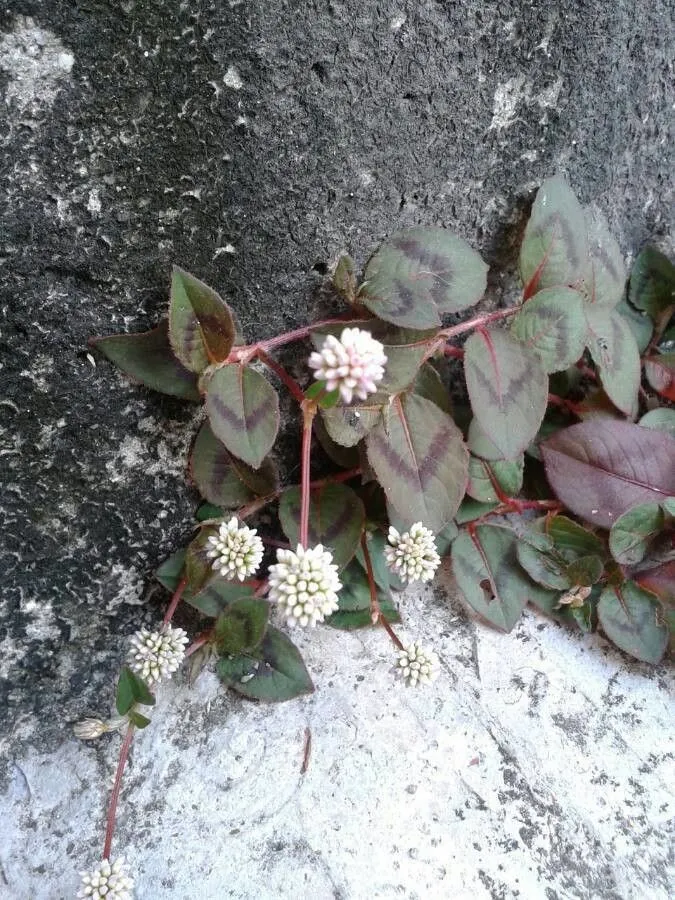
Author: (Buch.-Ham. ex D.Don) H.Gross
Bibliography: Bot. Jahrb. Syst. 49: 277 (1913)
Year: 1913
Status: accepted
Rank: species
Genus: Persicaria
Vegetable: False
Observations: Indian Subcontinent to S. China and Indo-China
Japanese knotweed, scientifically named Persicaria capitata, is a plant from the family Polygonaceae. This vigorous and resilient species was first described in 1913 in Bot. Jahrb. Syst., under the authorship of (Buch.-Ham. ex D.Don) H.Gross.
Its habitat spans a broad geographical area, ranging from the Indian Subcontinent to Southern China and Indo-China. Japanese knotweed is known for its aggressive growth patterns, often forming dense thickets that can outcompete native vegetation. The plant’s adaptability to various environments has allowed it to thrive in these regions.
Characteristically, Persicaria capitata has heart-shaped leaves with reddish hues and a distinctive pattern, adding to its ornamental value. The plant also features small, clustered flowers that are usually pink or white, blooming profusely during its flowering season. Despite its aesthetic appeal, Japanese knotweed is often considered invasive due to its ability to spread rapidly and disrupt local ecosystems.
Management and control of Japanese knotweed require diligent effort, as the plant can regenerate from even small root fragments. Methods to contain and eradicate its spread include mechanical removal, chemical treatments, and biological controls, though complete eradication can be challenging due to its robust nature.
Overall, Japanese knotweed’s resilience and aggressive growth make it both a botanical curiosity and a challenge for ecological management, necessitating ongoing research and effective management strategies to mitigate its impact on invaded habitats.
Eng: japanese knotweed, pinkhead smartweed, pink-head knotweed, pink-head persicaria, pink-headed persicaria, knotweed, pink-headed knotweed
Deu: kopf-knöterich, köpfchen-knöterich
Spa: nudosilla
Por: polígono-de-jardim
Fra: renouée capitée
Nld: kogelduizendknoop
Swe: slingerpilört, ampelpilört, slingerormrot
En: Japanese knotweed, Pinkhead smartweed, Pink-head knotweed, Pink-head persicaria, Pink-headed Persicaria, Knotweed, Pink-headed Knotweed
Nl: Kogelduizendknoop
Fr: Renouée capitée, Zerbe corail, Renouée, Herbe corail
De: Kopf-Knöterich, Köpfchen-Knöterich
Pt: Polígono-de-jardim
Es: Nudosilla
Sv: Slingerpilört, Ampelpilört, Slingerormrot
Taken Dec 17, 2017 by vini (cc-by-sa)
Taken Jan 27, 2014 by Tela Botanica − Liliane ROUBAUDI (cc-by-sa)
Taken Dec 12, 2019 by cuellar daniel (cc-by-sa)
Taken Jan 13, 2020 by skac (cc-by-sa)
Taken Aug 22, 2017 by Tercie Kadan (cc-by-sa)
© copyright of the Board of Trustees of the Royal Botanic Gardens, Kew.
© copyright of the Board of Trustees of the Royal Botanic Gardens, Kew.
© copyright of the Board of Trustees of the Royal Botanic Gardens, Kew.
Taken Oct 8, 2020 by Sara Anderson (cc-by-sa)
Taken Aug 12, 2022 by Annemarie Ahrens-Stehle (cc-by-sa)
Taken Jan 2, 2021 by Jana Bínková (cc-by-sa)
Taken Nov 3, 2021 by Villaronga Lorenzo Lois Antón (cc-by-sa)
Taken Oct 26, 2017 by Javier López (cc-by-sa)
Taken Jun 6, 2021 by Francesco Bosso (cc-by-sa)
Taken Dec 17, 2017 by vini (cc-by-sa)
Taken Aug 2, 2016 by debsasi (cc-by-sa)
Taken May 18, 2016 by Ricard Solana (cc-by-sa)
Taken Mar 6, 2016 by marielle groundwater (cc-by-sa)
Taken Jul 25, 2021 by Georgia C (cc-by-sa)
Taken Dec 17, 2017 by vini (cc-by-sa)
Taken Nov 29, 2020 by therese (cc-by-sa)
Taken Apr 30, 2019 by Pierre Bonnet (cc-by-sa)
Taken Sep 22, 2017 by Eva Sebrechts (cc-by-sa)
Taken Feb 24, 2021 by Disa Villada (cc-by-sa)
Taken Dec 17, 2017 by vini (cc-by-sa)
Taken Jan 15, 2014 by Tela Botanica − Liliane Roubaudi (cc-by-sa)
Taken Jan 15, 2014 by Tela Botanica − Liliane Roubaudi (cc-by-sa)
Taken Aug 17, 2017 by Tela Botanica − Sylvain PIRY (cc-by-sa)
Taken Jan 15, 2014 by Tela Botanica − Liliane Roubaudi (cc-by-sa)
Taken Jan 27, 2014 by Tela Botanica − Liliane ROUBAUDI (cc-by-sa)
Family: Myrtaceae Author: (F.Muell.) K.D.Hill & L.A.S.Johnson Bibliography: Telopea 6: 402 (1995) Year: 1995 Status:…
Family: Rubiaceae Author: Pierre ex A.Froehner Bibliography: Notizbl. Bot. Gart. Berlin-Dahlem 1: 237 (1897) Year:…
Family: Sapindaceae Author: Koidz. Bibliography: J. Coll. Sci. Imp. Univ. Tokyo 32(1): 38 (1911) Year:…
Family: Asteraceae Author: A.Gray Bibliography: Pacif. Railr. Rep.: 107 (1857) Year: 1857 Status: accepted Rank:…
Family: Fabaceae Author: Medik. Bibliography: Vorles. Churpfälz. Phys.-Ökon. Ges. 2: 398 (1787) Year: 1787 Status:…
Family: Aspleniaceae Author: (Cav.) Alston Bibliography: Bull. Misc. Inform. Kew 1932: 309 (1932) Year: 1932…